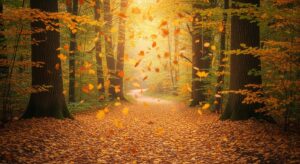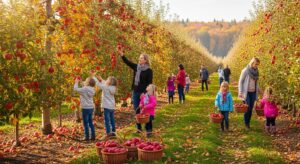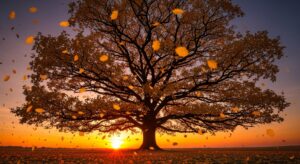There’s something undeniably magical about fall. As summer fades and cooler winds sweep through, the landscape transforms into a breathtaking canvas of fiery reds, golden yellows, and warm oranges.
At the heart of this seasonal shift are fall trees nature’s masterpiece that remind us of beauty, change, and resilience.
In this article, we’ll explore the magic of fall trees, their science, symbolism, and the ways they inspire everything from art to everyday living.
🍁 1. The Science Behind Fall Colors

The vivid hues of fall aren’t just for show they’re the result of fascinating natural processes.
-
Chlorophyll Breakdown: During summer, chlorophyll gives leaves their green pigment. As sunlight decreases in autumn, chlorophyll fades away.
-
Carotenoids & Anthocyanins: Carotenoids reveal yellows and oranges, while anthocyanins create reds and purples.
-
Cool Nights, Sunny Days: These conditions make colors especially vibrant, turning forests into radiant works of art.
🌿 In essence, fall trees are not dying they are simply preparing for winter’s rest.
🍂 2. Symbolism of Fall Trees

Throughout history, trees in autumn have been symbols of:
-
Change & Transformation: Just like the leaves, we too shed what no longer serves us.
-
Letting Go: Falling leaves remind us that endings can be beautiful.
-
Balance & Reflection: Autumn is a time to slow down and appreciate life’s cycles.
For many, walking through fall trees feels like entering a natural cathedral a place of peace, wisdom, and quiet reflection.
🌳 3. The Role of Fall Trees in Ecosystems

Beyond their beauty, fall trees play an essential role in sustaining life:
-
Habitat: Birds, squirrels, and insects find shelter in branches and fallen leaves.
-
Soil Health: Decomposing leaves enrich the soil with nutrients.
-
Climate Regulation: Forests absorb carbon dioxide, keeping air clean and temperatures balanced.
Fall reminds us that trees are not just seasonal decorations, but pillars of the planet’s health.
🖼️ 4. Inspiration for Art, Literature, and Culture

Fall trees have long inspired artists and writers:
-
Poetry: From Robert Frost to Emily Brontë, fall has been a muse for reflection and nostalgia.
-
Paintings: Artists capture autumn’s fiery palette as symbols of transition and fleeting beauty.
-
Cultural Festivals: From Japan’s Momijigari (maple leaf viewing) to North America’s fall fairs, trees are central to cultural celebrations.
🍂 Fall trees aren’t just scenery they’re storytellers woven into human creativity.
🍏 5. Orchards and Harvest Season

In rural landscapes, fall trees signal abundance. Apple, pear, and chestnut trees bend heavy with fruit, while families gather to harvest and celebrate.
-
Apple Orchards: A symbol of autumn joy cider, pies, and hayrides among trees bursting with fruit.
-
Nut Trees: Walnuts, pecans, and chestnuts offer rich harvests before winter.
-
Community Bonding: Orchards bring people together to pick, share, and celebrate the season of plenty.
🚶 6. The Joy of Fall Foliage Walks

Few activities compare to wandering among fall trees.
-
Mindful Walks: Crisp leaves crunching underfoot, cool breezes, and fiery canopies overhead create a meditative experience.
-
Photography: Fall trees provide endless opportunities for stunning shots.
-
Travel Destinations: Vermont (USA), Kyoto (Japan), and Bavaria (Germany) are famous for unforgettable autumn landscapes.
Fall trees aren’t just viewed they’re experienced.
🏡 7. Bringing Fall Trees Home

You don’t need a forest to enjoy the magic of autumn.
-
Planting Ornamental Trees: Maples, dogwoods, and birches bring vibrant fall colors to home gardens.
-
Decorating with Leaves: Pressed leaves, wreaths, and centerpieces capture fall indoors.
-
Firewood & Mulch: Fallen branches and leaves provide practical use while completing the seasonal cycle.
Nature’s gifts can be cherished in both large landscapes and small backyards.
🌏 8. Lessons We Learn from Fall Trees

Fall trees do more than please the eye they teach us life lessons:
-
Embrace Change: Seasons shift, and so must we.
-
Let Go Gracefully: Just as leaves fall, letting go of burdens makes way for renewal.
-
Find Beauty in Transition: Even endings can be colorful and meaningful.
-
Rest is Necessary: Trees pause in winter, reminding us that rest is part of growth.
In this way, fall trees are timeless teachers.
✨ Conclusion: The Magic of Fall Trees

Every autumn, trees gift us a reminder of transformation and resilience. They show us that letting go can be beautiful, that endings carry wisdom, and that change is a season to be embraced, not feared.
Whether strolling through fiery forests, sipping cider in an orchard, or simply gazing at a tree outside your window, fall trees bring a magic that nourishes both soul and planet.
🍁 In this season of change, may we learn from the trees to stand tall, adapt gracefully, and shine brightly in every transition.
🍁 10 FAQs on Fall Trees
1. Why do fall trees change color?
Fall trees change color because chlorophyll breaks down as days shorten, revealing pigments like carotenoids (yellow/orange) and anthocyanins (red/purple).
2. Which trees have the most vibrant fall colors?
Maples, oaks, sweetgums, dogwoods, and birches are known for their spectacular autumn displays.
3. Do all trees change color in fall?
No, evergreen trees such as pines and firs remain green year-round, while deciduous trees shed leaves in fall.
4. What conditions make fall colors brighter?
Cool nights, sunny days, and moderate rainfall enhance vibrancy. Too much rain or frost may dull colors.
5. How long do fall tree colors last?
Peak foliage typically lasts 2–4 weeks depending on weather and tree species, though timing varies by region.
6. Are fall leaves good for my garden?
Yes! Fallen leaves enrich soil, improve structure, and can be used as mulch or compost.
7. Can I grow fall-color trees in my backyard?
Yes. Ornamental trees like Japanese maples, dogwoods, and red maples thrive in many residential landscapes.
8. What’s the best time to plant fall trees?
Early fall is ideal because soil is warm, air is cooler, and roots establish before winter.
9. Do fall trees help wildlife?
Absolutely. Trees provide food (nuts, fruits), shelter, and nesting spaces for birds, squirrels, and insects.
10. Why are fall trees considered symbolic?
They symbolize change, transformation, letting go, and the beauty of life’s natural cycles.